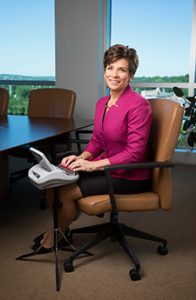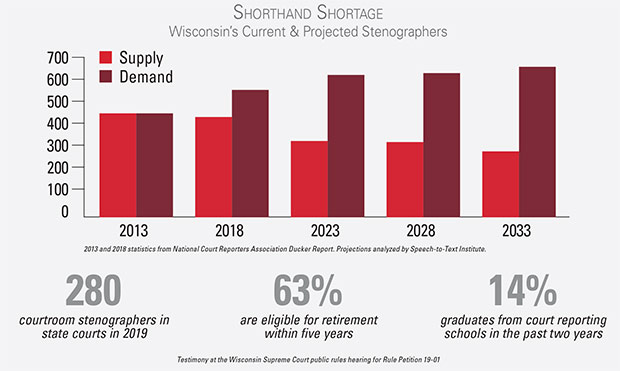LOSS FOR WORDS: Stenographer shortage prompts industry to seek out different solutions
By: Michaela Paukner, [email protected]//December 5, 2019//
LOSS FOR WORDS: Stenographer shortage prompts industry to seek out different solutions
By: Michaela Paukner, [email protected]//December 5, 2019//

Business is booming for Chris Willette, a stenographer and the owner of Willette Court Reporting in Wausau.
“I’m working more than I frankly would like to at my age, but someone has to keep the records,” Willette said.
Willette has been a court reporter for more than three decades. She said she has always been able to keep up with her bookings, but it can be difficult sometimes. To help, she recently hired a new court reporter fresh out of college — a hire she said she was lucky to make.
“That is a huge relief,” Willette said. “It’s hard to get young people, especially to move to Wausau.”
Willette and other court reporters say the fact that fewer people are entering the occupation is one of many reasons for an ongoing stenographer shortage — one that’s expected to worsen in the next decade.
State of the shortage
The Ducker Report from the National Court Reporters Association says Wisconsin had 430 court reporters in 2018 — more than a hundred fewer than needed. The Speech-to-Text Institute, a new nonprofit group meant to find ways to combat the stenographer shortage and advance speech-to-text technology, used numbers from previous years to project what the future of stenography will look like for Wisconsin (see infographic).
STTI estimates Wisconsin’s court reporter pool will decline by about 100 people in the next five years, while demand will continue to increase. By 2028, the nonprofit projects 307 people will be working as court reporters in Wisconsin, but the demand will be for nearly double that number.
In April, the Wisconsin Supreme Court held an open-rules hearing for a petition to recognize digital audio recording as a fully recognized method of taking the record in circuit courts. Supporters testified that 63 percent of the current court reporters in Wisconsin will be eligible for retirement in the next five years. Meanwhile, only 14 people have graduated from court-reporting schools in the past two years.
“All of these people who flooded the field back in the late ‘70s are now reaching retirement age, and people aren’t going into the field,” Willette said. “It’s like the perfect storm, and this shortage gets created.”
‘Nobody knows we exist’
Court reporting became a popular profession in the 1970s as many women started working part-time jobs. It offered the flexibility many needed to take care of family obligations. The standards for certification rose with the rush of interested applicants, limiting the pool of eligible candidates. Later, real-time captioning for broadcast again increased the demand for certified stenographers.
The shortage worsened as many students in recent decades began choosing to go for four-year degrees instead of two-year programs. Now, instructors at the two Wisconsin technical colleges offering court reporting programs say a lack of awareness about stenography is one of their biggest barriers to enrollment.
“Nobody knows we exist,” said Lisa Hubacher, court reporting program director at Madison Area Technical College. “If we do our jobs well, we are in the room, and we are not speaking. And now we can do it remotely, so we don’t even have to be there. We become the fly on the wall.”
Hubacher and Jackie Rupnow, president of the Wisconsin Court Reporters Association and instructor at Lakeshore Technical College, said exposing potential students to the occupation is essential to its future. They’ve done outreach through career fairs and promoted free online introductory court-reporting courses, like the National Court Reporters Association’s A-to-Z program.
“Students are touching the machine, learning the basics, and we’re giving them an idea of what the next two years of their life are going to look like,” Rupnow said. “The dropout rate for students who go through an A-to-Z program is drastically lower.”
Hubacher said stenography is a difficult to learn, and MATC has structured its program to give students the best chance for success. The school set up an online curriculum to give students the flexibility needed to balance school with full-time jobs and other commitments.
The customizable program paired with increased awareness has made a difference in enrollment. Hubacher said 60 students are now enrolled in MATC’s court-reporting program, up from just 15 students five years ago.

New technology, new issues
MATC plans to start offering classes on digital audio reporting in fall 2020 — positioning students for success as the industry changes.
In July, the state Supreme Court approved digital audio recording as a method of recording court minutes to help combat the stenographer shortage. Hubacher said all 72 Wisconsin counties are installing digital audio-recording equipment.
Rupnow believes digital systems can be used effectively in conjunction with court reporters, but she said difficulties arise when it’s used alone or by an untrained operator.
“The transcripts are horrendous,” Rupnow said. “There are courtrooms right now where clerks are turning on the equipment and leaving. We’ve got a national and statewide listserv of problems that have been encountered with these DAR systems with someone who is not certified.”
Rupnow said there is certification available for operating digital audio-recording systems, but it’s not required by law. The lack of certification and errors have many stenographers wary of the technology.
“We believe a stenographic court reporter ensures the most accurate and reliable record, but the other methods are promoting that they are a replacement,” Willette said. “They simply can’t do what a stenographic reporter can do.”
Bridging the technology divide
Jim Cudahy, executive director at STTI, understands the concerns. He previously served as the executive director of the National Court Reporters Association, and he’s aware of what he calls an “ongoing divide” between stenographers and technology.
“By no means are we an anti-stenographer organization,” Cudahy said. “We deeply respect the heritage of stenography and the standards of quality and accuracy, but we also likewise believe other technologies and other practitioners are capable of meeting those same standards.”
Cudahy started the nonprofit group in October to explore using technology to deal with the shortage of court reporters. His early goal is to assemble a group who can have genuine conversations about the future of stenography.
“We have some idea of where we want to go, but it will be built around conversations and initiatives we have as an organization and as a community,” Cudahy said. “We will work backward from there to establish standards, training programs and other services that will help the members of the industry meet the needs of the market.”
STTI is enlisting stenographers, law firms, educators and others affected by the court reporter shortage for its discussions. Cudahy said the nonprofit group is meant to maintain the integrity of the legal profession as it encourages the use of new technology.
“Attorneys and paralegals are accustomed to stenography and the quality product it generates,” Cudahy said. “They expect and demand quality, accuracy and fast turnaround of transcripts. They will become accustomed to the idea over time that digital recording and voice writing are capable of meeting the same standards.”
A viable occupation
Despite the difficulties and changes ahead, Rupnow, Hubacher and Willette said the future is bright for traditional stenography.
“We use that technology to our advantage, so we can still be a viable profession into the future,” Rupnow said. “We all believe that we are a very important, integral part of the judicial system.”
Hubacher said the use of new technology will cause some upheaval, but it’s ultimately just one of many changes she has adapted to in her more than 30 years in the legal profession.
“If you can go through school and attain the level of competency you need to graduate writing on a steno machine, there will always be a job for you,” Hubacher said.
Legal News
- State Bar leaders remain deeply divided over special purpose trust
- Former Wisconsin college chancellor fired over porn career is fighting to keep his faculty post
- Pecker says he pledged to be Trump campaign’s ‘eyes and ears’ during 2016 race
- A conservative quest to limit diversity programs gains momentum in states
- Wisconsin prison inmate pleads not guilty to killing cellmate
- Waukesha man sentenced to 30 years for Sex Trafficking
- 12-year-old shot in Milwaukee Wednesday with ‘serious injuries’
- Milwaukee man convicted of laundering proceeds of business email compromise fraud schemes
- Giuliani, Meadows among 18 indicted in Arizona fake electors case
- Some State Bar diversity participants walk away from program
- Wisconsin court issues arrest warrant ‘in error’ for Minocqua Brewing owner
- Iranian nationals charged cyber campaign targeting U.S. Companies
WLJ People
- Power 30 Personal Injury Attorneys – Russell Nicolet
- Power 30 Personal Injury Attorneys – Benjamin Nicolet
- Power 30 Personal Injury Attorneys – Dustin T. Woehl
- Power 30 Personal Injury Attorneys – Katherine Metzger
- Power 30 Personal Injury Attorneys – Joseph Ryan
- Power 30 Personal Injury Attorneys – James M. Ryan
- Power 30 Personal Injury Attorneys – Dana Wachs
- Power 30 Personal Injury Attorneys – Mark L. Thomsen
- Power 30 Personal Injury Attorneys – Matthew Lein
- Power 30 Personal Injury Attorneys – Jeffrey A. Pitman
- Power 30 Personal Injury Attorneys – William Pemberton
- Power 30 Personal Injury Attorneys – Howard S. Sicula











